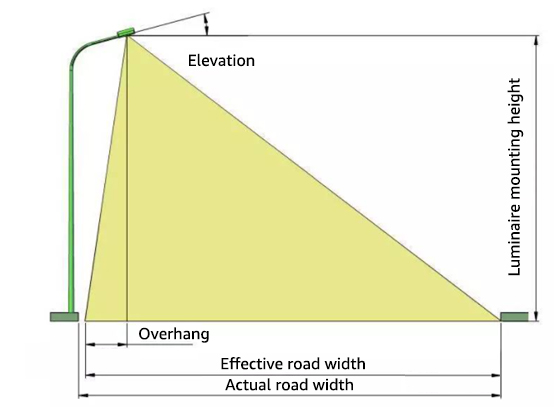What Are the Different Types of Lighting Fixtures for Commercial Areas?
HID shoebox lights with low conversion rates are highly efficient when measured at the source. However, it does not take into account the amount of light that hits the target area (system efficiency). System efficiency is affected by a myriad of factors, including losses due to trapped light, protective covers or lenses, non-standard operating temperatures, and power conversion losses. The system efficiency for HID shoebox lights is generally only 70% of the source efficiency compared to the LED shoebox lights (whose system efficiency is closer to 90%). Hence, it is obvious that the more practical lighting solution is the LED.
The significant advantage of HID shoebox light is that their initial purchase price will be much lower in some cases, particularly with low and high-pressure sodium bulbs. Typically, LED shoebox lights make up for their higher purchase price with reduced maintenance and energy costs across a specific payback period. Similarly, another explicit tradeoff with the HPS (High-pressure sodium-vapor) lamp, in particular, is its monochromatic yellow with an abysmal Color Rendering Index.
Furthermore, HID shoebox lights carry with them a myriad of inherent potential problems. Amongst them, the major issues include repetitive maintenance and replacement costs in both parts and labor (HID shoebox lights have a much shorter lifespan than LEDs), potentially hazardous waste (internal mercury), and dangerous emissions (UV). Such situations occur if the bulb breaks, the casing experiences some form of failure, or other similar concerns like longer warm-up times, inability to dim effectively, or shorter warranty coverage.
Therefore, though the trend nowadays is to go with LED shoebox lights, one needs to be cautious. Choosing products with a guaranteed lifespan is of utmost importance to avoid tensions, frequent maintenance work, and high costs associated with it.
How to Choose the Parameter of the Commercial LED Shoebox Fixture?
A sound and reliable lighting system that can improve night-time visibility will provide efficient, high-quality light with minimal glare.
The average road surface illuminance is a vital evaluation index for roadway lighting. The luminous flux may be calculated using the formula jotted below, which helps ascertain the total perceived power emitted by a light source.

E = Ø / A
Eav = F * U * K * N / (Weff * S)
W eff = Ws – XL
Where:
“Ø” = luminous flux, “E” = illuminance, “A” = irradiated area (m2)
“Eav” = average road surface illuminance, “F”= rated luminous flux (Lm)
“S” = luminaire mounting spacing (m)
“Weff” = effective road width, Ws = actual road width,XL = overhang
Due to the varying installation heights, elevation angles, layout methods, road widths, etc., of the street lights, we should also consider the rated luminous flux of the street light source, the “utilization factor (U).”
For the purpose of maintaining the average illuminance of the road surface, it is necessary to consider the lumen maintenance, the protection level, the cleaning cycle, and the “maintenance factor (K)” to calculate the rated luminous flux.
Since the street lights are arranged in different ways, such as a single row, double row symmetrical, double row staggered, etc., which affects the average illuminance, the “arrangement factor (N)” needs to be considered as well.
Table 1 Recommended Values for High Pedestrian Activity Areas

To explain the calculation method, we have illustrated an example below.
On the main road, with high pedestrian activity, the road width is 20m, luminaire mounting spacing 25m, installation height 10m, overhang length 1.5m, elevation angle 15°, and the luminaires are arranged on only one side of the road. What power should be selected?
Select the LED shoebox light with an IP65 protection level that suits the project environment.
Refer to table 1, and choose Eav = 20Lx.
Weff / H is 18.5 / 10 = 1.85, elevation angle 15°, certainty U is 0.69, K is 0.7.
20 = F * 0.69 * 0.7 * 1 / (20 – 1.5) / 25
F = [ (Ws – XL) * S] * Eav / U * K * N
= [ (20 – 1.5) * 25] * 20 / (0.69 * 0.7 * 1)
= 9250 / 0.483
= 19151 Lm
Generally, the lumen efficiency of LED Shoebox lights is 100-130Lm/W, but the corresponding power should be 150W-200W. Lepro provides LED shoebox luminaires with a lumen efficiency of up to 130Lm/W. Hence, only 150W power is enough.
Through the design software DIALUX, the LEPRO LED shoebox illuminants helps meet or exceed the maintained average horizontal luminance and average-to-minimum uniformity ratios.
How to Choose the Mounting Accessories of Commercial Shoebox Fixtures?
There are generally three installation methods for shoebox lights:
1. Slip Fitter: Round Pole

2. Direct Bracket: Square Pole

3. Trunnion Bracket: Wall Mounting

When positioned in parking lots and roads, we generally recommend choosing the first or second category depending on the actual installation situation.

For optical design or any questions, please contact Lepro. We provide various types of parking lot lights 100w to 300w for your choosing.



